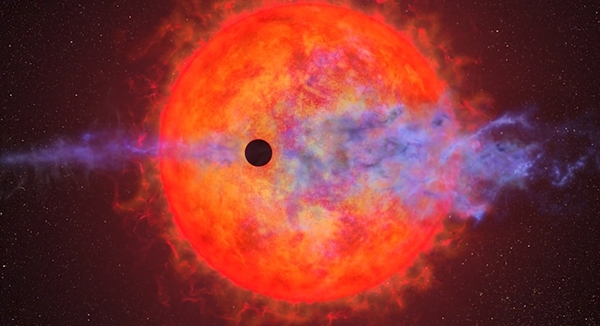Hubble Space Telescope Captures Dramatic Atmosphere Erosion of Nearby Exoplanet
TEN NEWS NETWORK

New Delhi, August 1, 2023: In a stunning astronomical discovery, the Hubble Space Telescope has observed the atmosphere of a nearby exoplanet being eroded by powerful outbursts from its parent star, AU Microscopii, or AU Mic.
Situated just 32 light-years away from Earth, AU Mic is a red dwarf star housing one of the youngest planetary systems ever witnessed, with an age of less than 100 million years.
The system was initially identified in 2020 during observations made by NASA’s retired Spitzer Space Telescope and the Transiting Exoplanet Survey Satellite. The presence of a gaseous world was unveiled through a slight dip in the star’s brightness, indicating the presence of an exoplanet orbiting in front of it.
Upon Hubble’s subsequent observation of one orbit of the exoplanet, named AU Mic b, which lasts 8.46 days, everything appeared normal. However, when the telescope returned for another look a year and a half later, astronomers were astounded by what they saw. AU Mic b, being the closest planet to the star, was enduring the brunt of the star’s radiation, leading to the evaporation of its hydrogen atmosphere. In the system, there are already at least two known exoplanets, with the possibility of more awaiting discovery.
The findings of this groundbreaking discovery have been accepted for publication in an upcoming edition of The Astronomical Journal. Keighley Rockcliffe, a doctoral candidate in physics and astronomy at Dartmouth College, Hanover, New Hampshire, and the study’s author, expressed astonishment at the unexpected results, saying, “We’ve never seen atmospheric escape go from completely not detectable to very detectable over such a short period when a planet passes in front of its star. We were really expecting something very predictable, repeatable. But it turned out to be weird. When I first saw this, I thought ‘That can’t be right.'”
This fascinating insight into the dynamic interactions between stars and planets sheds new light on the complexities of exoplanetary atmospheres and opens up exciting avenues for further exploration into the mysteries of the cosmos.

